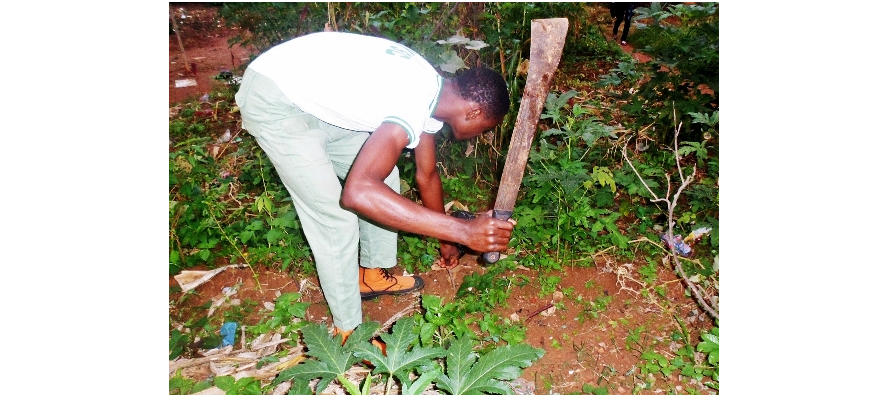The Tale of a 'Kopa' (Part VI): The Agricultural Kopa by Morayo Oshodi
Watch where you swing that cutlass!
The average Nigerian knows how to tell a "local breed" chicken from an agricultural one. This same distinction can be applied to individuals. I have always been indifferent about the lives of the plants and animals in my environment; all I cared about was their consumption, especially during celebrations like Christmas, Eid el-Kabir, birthdays, and weddings. During my NYSC year, however, I came to realise that plants and animals are more than just tasty meals: their lives aren’t too different to ours. The average ‘Kopa’ runs as far away from a rural assignment as possible, but as I had been posted to a village where farming was important, I decided to get to grips with this new environment.
The school at which I served had a large farm on which cash crops such as yam, maize, groundnut, cassava, sugar cane, tomatoes, and cashews were grown. The harvests were sold and the money raised was used for maintenance expenses. I loved going to the farm to watch the students cultivating the land. My students were passionate about farming, and some wanted to spend the rest of their lives as farmers. They taught me how to farm, something I never in my wildest dreams thought I could do. Even if they struggled in the classroom, the expertise they held in tilling the soil, and planting and watering the crops was admirable. I regularly assisted them on the farm (wearing my jungle boots in case I stepped on something dangerous). Tuesdays were the school’s day of labour. Students would gather on the assembly ground; the boys with hoes hanging from their left shoulders, the girls with brooms in their hands. Every student had a master (or teacher, for our non-British colonised readers) they assisted with chores. One such Tuesday, Mr Abubakar and I were supervising the students as they laboured away under the scorching sun. I moved briskly in my seven-over-seven like a soldier, inspecting the students’ efforts. Out of the corner of my eye, I caught a female goat with heavy breasts stretching to eat unripe bananas from a very small tree on the farm. I knew that animal – it was the same black-and-white skinned goat that had given birth two days earlier at the back of my lodge… On a quiet Sunday afternoon, I was awoken by the sound of a goat crying in pain. I rushed out to see what was happening. On getting outside, I saw the goat moving in a zigzag pattern. Had the goat eaten poison or did it suffer a snake bite? Suddenly, it ran smack into a tree trunk. I was terrified as I had never seen anything like this before. I thought at first it would be best to back off – perhaps the goat had a communicable disease that I might be the first to contract – but something told me to hang on a bit. The goat suddenly jumped up in the air and landed hard on its side. I shivered; I didn’t know what to expect next. All this while, the goat had barely registered my presence. It suddenly stood up and a sack of water fell from its behind. I dodged quickly, and I looked again I saw that the sack had broken. A little kid emerged from and began crying in a sharp bleat. Wow! I exclaimed. Eku Ewu… I didn’t realise that the goat was pregnant, as its stomach was not very big – one could easily have mistaken it for simply being well-fed. I watched the goat lick its kid until it was cleaned of blood. I looked in wonder at the mother and child, at the process of birth, at the pain which was suddenly over... “She must have come to get food for her kid,” I muttered. The labour prefect interrupted my thoughts. “Ma? You have been staring all day. Maybe you should go and rest.” Upon seeing the goat, he immediately picked up a stick and began to curse it. I motioned him to stop. “Don’t you know she just put to bed?” “Yes, ma. That’s how they use to come every time. We shall have a scapegoat soon.” Upon getting home from school, I peeped into our backyard. The goat was there with the kid, which was still too young to walk. I went into the kitchen and took out the peeled skins of some yams in a bowl to give to the mother and child. I saw a curious look in the mother’s face… it looked like she was thanking me. As I was teaching the next day, I heard a goat bleating. I heard some students giggling as I rushed out of the room. Another goat was running across the yard in a zigzag manner and bleating in an abnormal way. At one point it fell to the ground – but this one was definitely not pregnant it was a He-goat. I noticed the labour prefect amongst a group of laughing students, and he told me that the goat had been caught in the school farm eating bananas. “We poured petrol on its fur.” I was disappointed in them, and was glad that my she-goat – well, not mine, but still – was safely behind my lodge. The sight of the goat running helter-skelter was rather funny though, and I eventually started laughing along with the students. Yes, I became the ‘Agric Kopa’ who loved planting crops and rearing animals. From my prowess on the farm, you can tell that I am definitely not a local breed. Enjoyed the story of the agricultural kopa? Click here to read previous Tale of a 'Kopa' entries.





